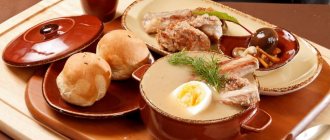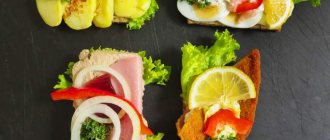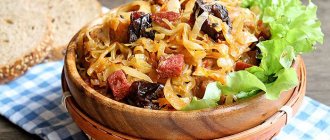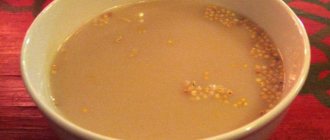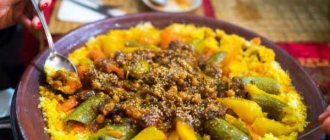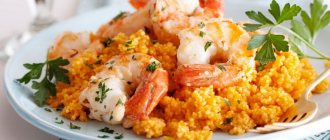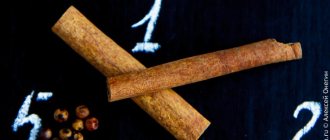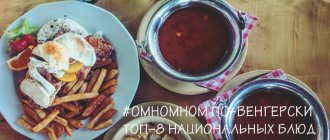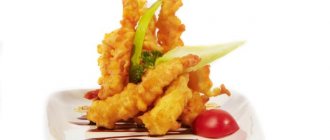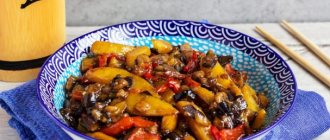Kyrgyzstan is a country where traditional nomadic and sedentary cultures merged at the crossroads of the Great Silk Road. Therefore, Kyrgyz national cuisine is an amazing combination of dishes from a variety of Central Asian nationalities: Kyrgyz, Uzbeks, Uyghurs and Dungans. A distinctive feature of Kyrgyz dishes is that they are all prepared exclusively from fresh ingredients and are rarely stocked up for future use, and the recipes for their preparation, although they seem very simple, actually contain many subtleties that are quite difficult to master.
It is also worth noting that almost all dishes of Kyrgyz cuisine have meat as the main ingredient: lamb, beef, horse meat and yak meat. This is due to the livestock-raising traditions of the nomadic Kyrgyz, which go deep into antiquity. Dairy products are also widely used. In the southern, agricultural regions of the country, in addition to meat, a large amount of fresh vegetables and seasonings are added to dishes.
Demdeme.
There is an old dish in Kyrgyz cuisine called kuurdak. This ancient dish has been known to the Kyrgyz people for a long time, in conditions of a harsh climate, in the highlands, this food was most optimally suited to the diet of my ancestors. Already at that distant time, they understood the need for preservation and long-term storage of food. Along with such types of meat preservation as drying and salting, they came up with the preparation of kuurdak. To do this, they cut the meat into small pieces, thoroughly fried it in fat and poured it into clay jugs so that the meat did not come into contact with air during storage; the fat served as an excellent preservative. Ready-made kuurdak, called tondurma...read more →
03/01/2016, 17:40cheftm_9
Additions and side dishes
Of course, Kyrgyz cuisine is not complete with meat alone. Seasonal vegetables, various cereals, flour products, eggs, and canned foods are eaten here as side dishes and additions to it.
To prepare salads and cold appetizers, tomatoes, radishes, sweet peppers, jusai, garlic, onions, cucumbers, cabbage, carrots, and herbs are used. Vegetables are eaten raw or boiled, sometimes stewed or pickled, or added to thick soups. Pumpkin is most often consumed, especially in the south of the country: it is prepared as an independent dish, mixed into dough, and stewed with meat.
It must be said that the Kyrgyz vegetable table was not always so diverse. All this wealth appeared in connection with the development of agriculture and horticulture.
From cereals, rice, barley, millet, peas, and jugara are added to soups. It is interesting to eat sour cereal soups with ayran. Vegetable oil, fermented milk products, sauces, and vinegar are added as dressings to first and second courses.
Yeast bread and flatbreads are cooked either in a tandoor oven or on an inverted cauldron over coals.
Distinctive features
Having similarities with the cuisines of neighboring eastern countries (especially Kazakhstan), the menu of the people of Kyrgyzstan still has its own characteristics. For centuries, the people were nomadic and did not engage in agriculture. Because of this, the basis of the national food is meat and livestock products (milk, butter, fermented milk products).
Most dishes of Kazakh and Kyrgyz cuisine are prepared according to the same recipe.
However, the diet of residents of Kyrgyzstan has its own interesting features:
- use of large quantities of boiled meat and offal;
- rich soups, broths;
- basic diet - flatbread, kumiss, ayran;
- limited amount of vegetables and fruits (especially in the cuisine of the northern regions of the country);
- preparing dishes based on lamb, beef and dough - khashan, samsa;
- any meal is accompanied by drinking tea from bowls, served with nan cakes;
- seasonality of the diet: in summer it is dominated by plant products, in winter - by meat;
- adding spices and herbs to food that improve taste and stimulate digestion;
- an abundance of flour products - flatbreads, pancakes, pancakes.
A Kyrgyz dish that is not found among other nations is called kemech. These are coin-sized cakes baked in ashes. They are placed in warm milk, flavored with suzma (a salted analogue of cottage cheese) and butter.
Kyrgyz appetizer Susamyr
INGREDIENTS medium-sized onion - 1 onion flour - 1.5 tbsp.
l. grated cheese – 50 g chicken liver – 300 g sour cream – 200 g bell pepper – to taste salt – to taste vegetable oil – 2 tbsp. l. PREPARATION METHOD Step 1 Clean the liver from fat and films, rinse and cut into pieces. Peel and chop the onion. Step 2 Heat vegetable oil in a frying pan and fry the onion for 5 minutes. Add liver and cook for 8 minutes. Step 3 Place sour cream in a small saucepan, dilute with 1 tbsp. l. water, salt and pepper to taste, bring to a boil. Add flour while stirring and heat for 1-2 minutes. Place the liver and onions in ceramic molds, pour in sour cream sauce and sprinkle with cheese. Bake in the oven until golden brown, 10 minutes. When serving, garnish with herbs. 02.06.2015, 13:05cheftm_9
Step-by-step preparation
To properly prepare the original Kyrgyz Botko porridge, the following steps must be followed:
- The first step is to heat the broth to a boil. Then corn grits are poured into it. For this recipe, it is best to use a coarsely ground product.
- You also need to add pre-cut tomatoes into small cubes, chopped onions, and garlic into the porridge. Everything is seasoned with salt, pepper and paprika.
- Cook the botko over very low heat until done. Then it needs to be cooled and divided into portions on plates.
- When ready to serve, the porridge is decorated with chopped green onions, as well as small pieces of chopped meat.
If desired, this Kyrgyz national dish can be prepared with chicken or game broth, then it will acquire a slightly different taste.
Main dishes of Kyrgyz cuisine
The cuisine of Kyrgyzstan is reminiscent of all the cuisines of the Turkic peoples, but there are differences in preferences. Thus, the Kyrgyz from the northern part in their culinary habits are similar to the inhabitants of Kazakhstan, and in the south they have much in common with the Tajiks and Uzbeks. The former have thick beshbarmak in their diet, while the latter have aromatic crumbly pilaf.
Meat occupies the main place on the tables of the residents of Kyrgyzstan. There are at least 20 beef or lamb dishes on the menu of any restaurant. But yak meat or horse meat are considered especially valuable delicacies - you will have to pay more for them. As for the method of preparing meat, Kyrgyz chefs do not invent complex recipes: they put it in a cauldron and boil it.
Among the most ancient dishes of Kyrgyz cuisine is tash kordo. It appeared among nomads, and today, in accordance with traditions, it is prepared according to the original recipe. The lamb is marinated and well seasoned with onions, spices and salt. The pieces of meat are then suspended in a pre-dug hole and kept over the fire for several hours. The finished meat is so tender that it melts in your mouth.
One of the most popular Kyrgyz dishes is kulchetai. The meat is boiled and removed from the pan, and strips of dough and vegetables are placed in the finished broth. Sliced meat, dough and vegetables are placed on a dish, the broth is served separately. As for soups, it is worth trying shorpo, which is usually cooked in the fall from goat meat, potatoes, carrots and onions. In other seasons, shorpo is made from lamb and a lot of herbs are always added: parsley and sorrel. Soups are also made from milk. They add an analogue of homemade noodles and ghee.
People in Kyrgyzstan love khoshans, a dish reminiscent of manti, but with some differences. Chopped meat is placed in khoshans and then fried in oil. As a result, the dish gets a golden crust. Khoshans are usually eaten with fermented milk drinks. Not a single meal for the Kyrgyz is complete without flour products. Every time on the table there are hot flatbreads (classic or with onions) and pieces of dough fried in oil.
After the main meal, Kyrgyz people like to treat themselves to confectionery. For example, oriental sweets navat, halva and parvarda. But sometimes nuts (almonds, pistachios), honey, a mixture of honey and nuts, or dried fruits are used as desserts. Another dessert is baked apples, with fruit or berry syrup with gelatin poured into the middle. After baking, the syrup hardens, and the finished apples can only be sprinkled with powdered sugar.
Content:
Kyrgyz cuisine reflects the lifestyle and traditions of the freedom-loving nomadic people. It is based on simple, high-calorie and nutritious dishes.
You can try national delicacies during a tourist trip around the Central Asian country. The food is also easy to prepare yourself using traditional recipes.
National dishes of Kyrgyz cuisine.
Features of Kyrgyz cuisine
As already mentioned, Kyrgyz cuisine is mainly based on meat products, which are seasoned with a large variety of spices and herbs. In addition, fermented milk products such as ayran, kumiss and many other drinks are especially popular. Well, we can’t forget about interesting sweets. Halva, navat and even various pastries that are unique to this country seem to immerse people in its history.
It is worth noting: dishes of this cuisine can be divided into those that are consumed every day, as well as festive and ritual ones. Quite a large amount of national food is served only for some occasion in life. For example, newlyweds at a wedding are always served ustukans, which are tubular bones with meat, cut from brisket.
But in general, Kyrgyz cuisine prefers to preserve as much as possible its original appearance and taste of products, that is, it will be very difficult to find mashed potatoes or chops there. Among the particularly popular dishes are:
- Soups: shorpo (a dish based on lamb broth with potatoes, tomatoes and green onions) and kesme (vegetable noodle soup).
- Main courses: beshbarmak (lamb with noodles and spicy sauce), pilaf and kebab in Kyrgyz style.
- occupy a special place. The most famous are various flatbreads, chak-chak, manti, brushwood, and khoshans (flatbreads with minced minced meat).
Goshkiide
Goshkiide are one of the most interesting Kyrgyz national dishes. Balls filled with meat, that's exactly what they look like. It is a kind of pastry similar to meat pies, which are prepared from hard, salty dough. It is worth noting that they are always prepared only in the form of small balls, the diameter of which does not even reach 5 cm. In addition, such pies can have only one filling - a mixture of minced beef with finely chopped onions. But despite this, this dish has a very interesting taste that is definitely worth trying.
Meat dishes
Kyrgyz cuisine is full of meat and meat-based dishes. Most often, lamb is used here, although quite recently the “main meat” of the Kyrgyz people was horse meat, which is still highly valued today. In addition, beef, poultry, game meat (roe deer, mountain goat and sheep) are used, but not pork - for religious reasons.
The meat is served with broth, with a variety of sauces, with cereals and vegetables, but most often with dough (beshbarmak, samsa, gashnan, khoshan, goshkide, manti, etc.).
The main method of cooking meat is boiling; stewing or roasting over coals is much less common. Heavy meat dishes are consumed in Kyrgyzstan mainly in the evening.
Some of the Kyrgyz meat dishes are their own inventions, others are borrowed from neighboring nations (pilaf, samsa, shurpa soup, lagman, manti, shish kebab).
One of the most famous and popular dishes in the country is beshbarmak - boiled and finely chopped young beef, served with strong broth and homemade rectangular noodles. Whole large pieces of lamb on the bone are distributed to the diners in a hierarchical order, and the most delicious pieces (the brain and eyes) are given to the guests. A variety of beshbarmak without noodles, but with a lot of onions and ayran is called naryn.
People also like to cook kulchetai, pilaf, lagman, and kuurdak from lamb.
The favorite horse meat dish in Kyrgyzstan is boiled sausage with fat and spices - chuchuk, which is consumed chilled both on its own and as part of other dishes (for example, sprinkled with pieces of beshbarmak).
Botko
Botko, better known in Russia as porridge, is one of the favorite dishes in Kyrgyzstan. There are several Kyrgyz national dishes made from corn grits, but of these, botko is the one that can most often be found in the diet of ordinary people. It is cooked in broth, which gives the cereal a pleasant taste and aroma, and also increases its calorie content, which is necessary after a hard day.
To prepare botko with corn grits you will need:
- 1.5 liters of meat broth;
- 300 grams of corn grits;
- 1 tomato;
- 1 onion;
- a small bunch of green onions;
- a clove of garlic;
- 100–150 grams of boiled meat;
- bay leaf, pepper, paprika and salt to taste.
Ingredients and cooking technology
To prepare goshkiide you will need:
- 300 grams of flour;
- half a glass of water;
- 250 grams of quality ground beef;
- 1 onion;
- 50 grams of butter;
- black pepper and salt to taste.
First of all, you need to prepare all the necessary ingredients. It is best to prepare ground beef at home, although you can also purchase it in a ready-made form at the store if you don’t want to work on it.
Then they begin to prepare the dough. To do this, add 7–10 grams of salt and a tablespoon of pre-melted butter to the water. The flour is thoroughly sifted and added to the liquid, and then a stiff dough is kneaded.
While the dough is resting, you need to prepare the filling. First, the onion is finely chopped, and then it is added to the minced meat. Everything needs to be well salted and peppered, and then mixed.
The dough is divided into 6 parts. You need to use your hands to make thick flat cakes, onto which you place about a couple of spoons of filling. The edges are folded so that you get a ball with filling inside.
Goshkiide are baked in an oven preheated to 180 degrees on a baking sheet covered with parchment. Before putting the balls inside, they need to be greased with beaten egg.
The pies take about half an hour to prepare. As soon as they are removed from the oven, they need to be greased with butter and served. This Kyrgyz national dish can be eaten either hot or cold.
Chuchuk
Chuchuk is a Kyrgyz national dish, which is prepared mainly for major holidays in the fall, when residents begin slaughtering livestock. This meat dish is very nutritious because it is prepared from a large amount of horse meat. It is worth preparing for the fact that it will take quite a long time to cook the chuchuk, since it is cooked over low heat for about an hour and a half, but the meat turns out to be very tender. To prepare this national Kyrgyz dish you will need:
- 1 horse rib, or kabyrga;
- 300 grams of kazy, or horse belly fat;
- about 30 cm of horse intestine;
- a couple of cloves of garlic;
- onion;
- Seasonings you will need are red and black pepper, salt and bay leaf.
Osh Shurpa recipe
Shurpa is cooked in a cauldron, but those who don’t have it can use another vessel. So, let's begin:
I’ll make a reservation right away: take the meat that is not frozen, because all the juices leave frozen meat after defrosting, and after cooking it can be tough and dry (not in the literal sense, of course!) I usually take the back part. There's more meat there. If you take it in one piece, then we cut it up, but be sure to leave more meat on the bone so that there is something to gnaw on. Soak chickpeas (nukhat) 3 hours before cooking. I poured boiling water on it. Since I don’t like a lot of peas in shurpa, I took a small handful.
Pour clean water into the cauldron. I have a 5-6 liter cauldron. Add the meat with the bones and put it on the fire. As soon as it boils, throw in a pinch of salt and add the nuhat. Salt will allow you to collect more foam. Remove the resulting foam completely so that the broth is clean. Let's turn down the fire.
During this time, cut one onion into half rings, and cut the second in half. We also clean the carrots and cut them into 3 parts. I cut diagonally. Our meat is cooked, throw in the chopped onion and lower our onion, cut in half. Cook the broth for 30-40 minutes.
Then we take out our onion and, without sparing, dispose of it in the trash bin. She has already given up her taste and is no longer needed. Now take a pinch of cumin (I take Uzbek black cumin, it’s more aromatic), rub it lightly in your palms and pour it into the broth.
If you want it spicier, you can add a pod of hot pepper, but only so that it is without cuts or breaks. Intact. Otherwise there will be a stomach fire! And add carrots. Let it cook for another hour. Let's take out the hot pepper. Make sure that the shurpa does not boil too much, otherwise the broth will become cloudy. But we don't need it.
After an hour, add a turnip cut in half. Cut the potatoes into 4 parts, if you have small potatoes, then cut them into halves. Then we cooked it a little, no more than 5 minutes. During this time, remove the skin from the tomato. I take cherry type tomatoes, but not small ones, but these ones, 7 cm in diameter. I don’t like it when there are tomato seeds in the shurpa. I have such a quirk! Who cares, can take ordinary large tomatoes and simply cut them into 4 parts.
We put the tomatoes in the shurpa and put the bell pepper there, previously peeled and cut into quarters. Let's cook.
While it's cooking, chop the greens. Cilantro, parsley and maybe a little more basil (don’t overdo it with basil). Place the greens in the cauldron and add salt to the shurpa. Cook for another 5 minutes. Check the vegetables for readiness. The potatoes should not be boiled, otherwise they will ruin the color of the shurpa. Of course, this will not affect the taste, but it will definitely add thickness.
Shurpa is served in deep bowls (pials). If you have a lot of people, you can show off. We take out large pieces of meat with bones and vegetables on a separate plate. And pour the broth into bowls, sprinkling fresh cilantro and parsley on top.
Well, it looks like I haven’t forgotten anything! Bon appetit!
Yutaza Kyrgyz cuisine
For dough: 1.5 tbsp.
wheat flour 0.5 tsp. dry yeast 0.5 tsp. salt 0.5 tbsp. warm water To grease the dough: 2 tbsp. l. vegetable oil Preparation: Prepare a simple straight yeast (sour) dough: dilute yeast and salt in water, pour into a bowl with flour, knead into a loose elastic dough, cover with a cloth and leave in a warm place for 2-4 hours. After this, divide the dough into four parts, stretch each part with your hands into a very thin cake (square or circle). Grease the flatbread well with oil and roll it into a tube, the ends of which are pinched. Steam until done 01/09/2015, 09:05cheftm_9
0
0
comments
Sweets and drinks
In addition to the fermented milk drinks described above, the main and favorite drink in the country is tea, and, unlike neighboring Kazakhstan, it is pressed green long tea. It is traditionally consumed at the beginning and end of each meal, and is usually drunk from porcelain bowls, sometimes flavoring the hot drink with milk and adding a little salt.
However, there is another tradition of drinking tea here. Atkanchay - a thick mixture of tea, milk, butter, sour cream, flour and salt - is drunk when you urgently need to restore strength.
A traditional treat for tea is flour products, the variety of which Kyrgyz cuisine can truly boast of. Previously, the only sweets on the Kyrgyz tables were imported dried fruits, nuts, and crystalline grape sugar. Nowadays you can try boorsoks (cut pieces of rolled dough fried in oil), choymo tokok (brushwood-type cookies), kyomöch (tiny flatbreads baked in ash), thin puff pastries made from yeast dough, and pancakes.
In addition to pastries, tea is served with honey, fresh and dried fruits, nuts, kaymak, and hot milk.
Another interesting national drink is bozo - a unique type of kvass made from wort on crushed wheat grains.
In general, given the variety of products and recipes and the proverbial local hospitality, you certainly won’t go hungry in Kyrgyzstan. Therefore, if you are wondering where to fly to Asia, feel free to choose this country. And BiletyPlus.ru will be happy to help you find a hotel with the most favorable conditions and to Bishkek or Osh.
